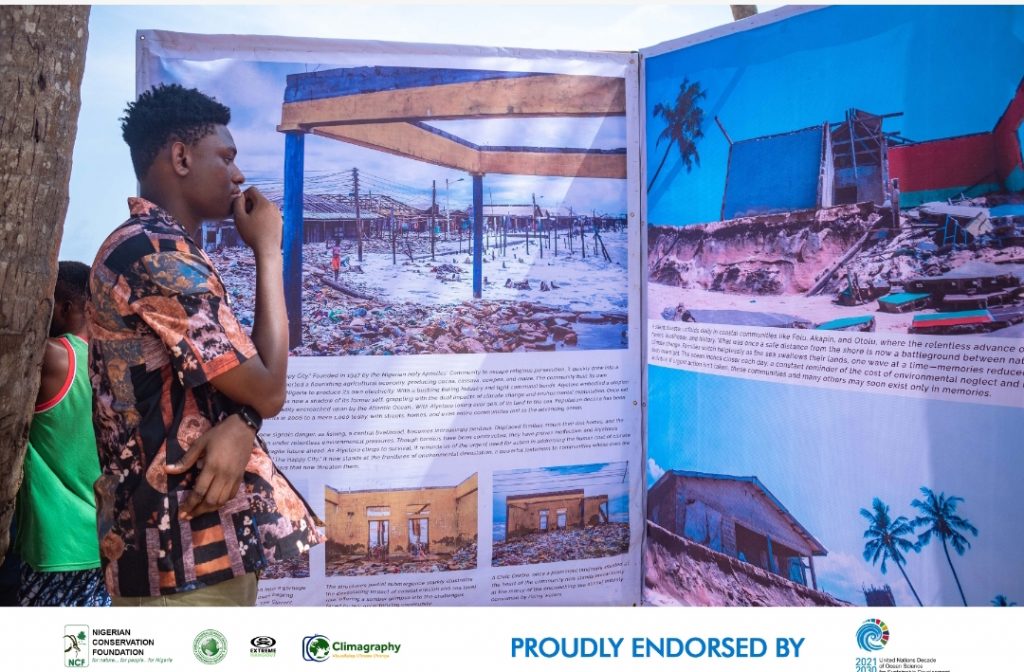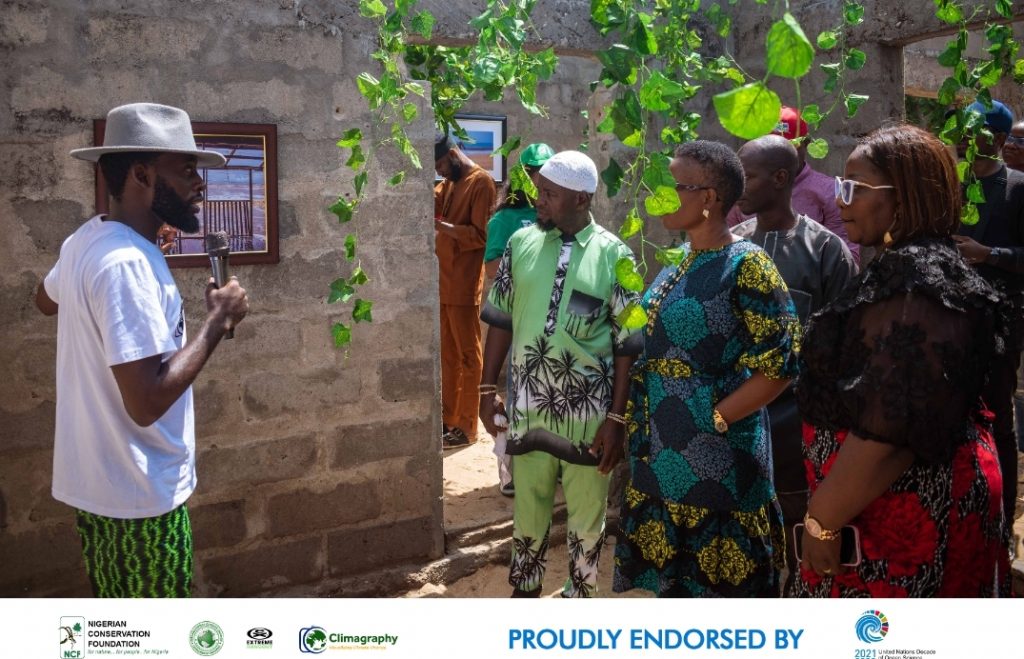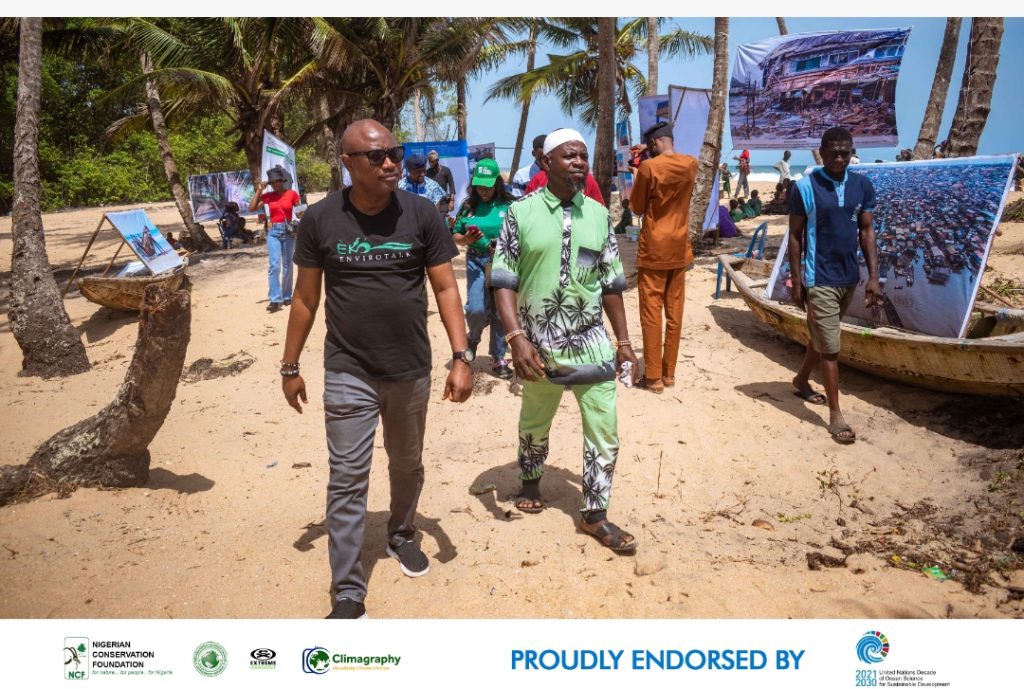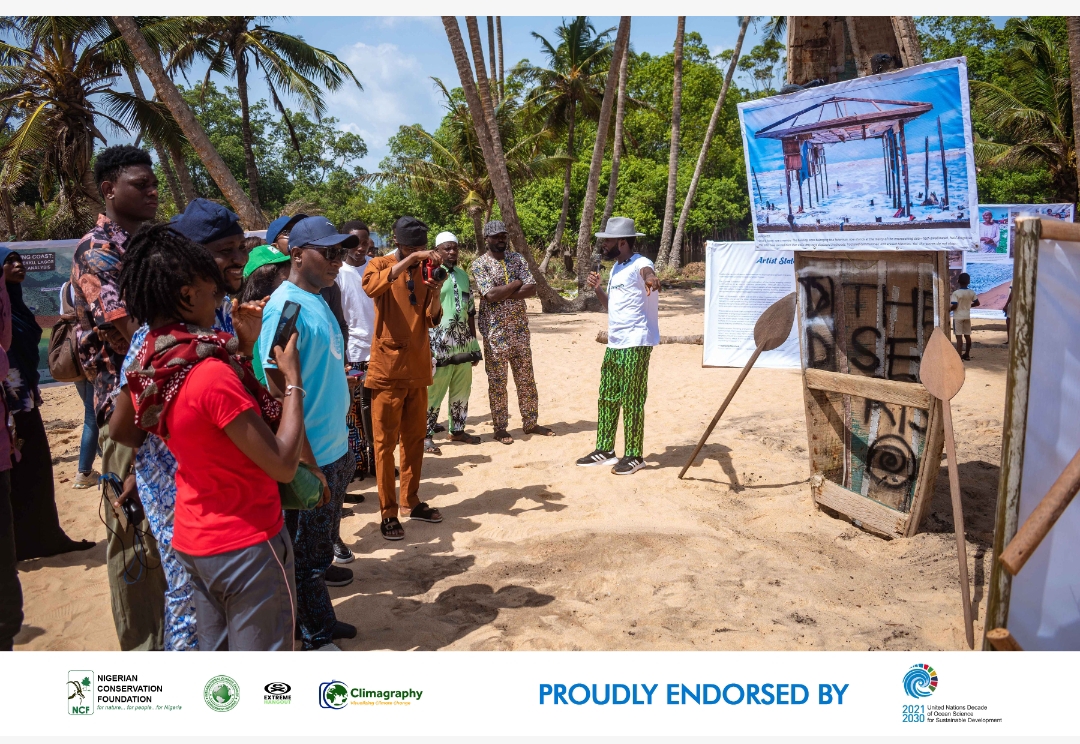By Mayowa Adebote
Founded by settlers from the Ise community, fading graveyards dated as far back as 1955 suggest that this community has long been habited before Nigeria’s independence.
The original name Akode-Odo translates to “the first to settle close to the sea”. For these first settlers, fishing and selling coconut products were the motivation as they provided them significant economic leverage. With the Atlantic Ocean many kilometres away, this island became a home for many.
However, the sea that once provided sustenance is now a source of fear. Locally known as Olokun, the god of the sea is now viewed as a destroyer. “The sea has no mercy,” says a local elder. “It is swallowing everything we love.” Year after year, the ocean moves closer eating up homes, lands, and even exhuming graves of loved ones.
With more than half of the community buried under the rising sea, there are still a few legacies and memorials left. Like Oluweri, the village’s first well which was once the only source of fresh water but now gives salt water. Other wells that aren’t bearing salt water have dried up. Attempts to install a solar borehole once offered hope — but soon broke down in months and it has since been three years without clean water.

“It’s been 14 years since we had any form of electricity in this community”, says locals. Solar streetlights were once installed raising hopes of electrifying the community but are now rusted, bent, and decaying. Children under 14 have never seen a working lightbulb, TV, or fan in this community. Those with mobile telephones walk long distances and pay ₦200 at a stall each time they need to charge their phones.
With no options to choose from, young men in the community still rely on fishing as a means of economic stability and to meet their family needs. What used to be a profitable profession is now a gamble – with the cost of fuel to power their boats and the reluctance of the sea to yield fish.
“Na hope fisherman get, no be say he keep fish for inside water,” says Kamarudin, a fisherman who has spent his life on the water. “We spend all our money on fuel, but the sea gives us nothing. We come back empty-handed sometimes.” It is a cycle of desperation and defeat. The fishermen invest their savings, their energy, and their hopes into the sea, only to have it take more and give less. They feel like they are fighting a losing battle, one that they can never win.

While the rising sea level is a constant threat, the rainy season brings with it desperation for people in the Akodo-Ise community. As the rain descends, men – young and old begin to dig temporal trenches 12 feet deep to keep their homes from drowning.
Though founded in 1953, the only primary school in the community is often deserted. One might suggest that education might help the younger ones escape the fate of their parents, but without books, electricity, or a future to aspire towards, children say they feel trapped and unable to picture the world outside their village.

“We don’t have a future here,” says Bukola, a young woman from the village. “There’s nothing left for us. The land is sinking, the sea is taking everything, and we are just stuck here, waiting for something to happen.”
Even the only central mosque, once a spiritual refuge is no longer considered safe as it now lies too close to the encroaching sea. “We can no longer pray at the mosque,” says Damilare, a community youth. “The sea is too close. We fear for our lives.”
Iye Iya has seen it all. At 90, her house is gone, she now lives in a hut made of palm leaves. “I have lost my home,” says Iye Iya, her voice trembling with grief. “I never thought I would end my days like this, living in a hut made of palm leaves. But what can I do? The sea has taken everything.” Her story is not just hers alone. It reflects the plight of every person in Akodo-Ise, individuals who have lost everything and now live in the shadow of a world slipping away.
They want out. They need out. But no one listens. “We need to leave,” says Adebayo, a father of three. “If we stay here, we will drown. There’s no future here anymore. The sea is taking everything.” The villagers of Akodo-Ise are tired, tired of waiting, tired of struggling, and tired of hoping for a future that seems to slip further out of reach every day.
The long-silenced voices of the Akodo-Ise community are gradually being heard, thanks to Adebote Mayowa, a Nigerian topmost environmental photographer whose recent project, The Current, shines a spotlight on the challenges faced by coastal communities in Nigeria.
Instead of showcasing his work in luxurious galleries, Mayowa held a solo exhibition in the crumbling palace of the traditional ruler, bringing global attention to this community and sprinkling rays of hope. For two unforgettable days, the serene yet struggling coastal community of Akodo-Ise came alive as it played host to The Current – a groundbreaking visual exhibition that immersed visitors in the climate realities facing Lagos’ most vulnerable populations. Held on 4th and 5th April, the event drew people from far and wide—artists, activists, journalists, policymakers, and curious locals—all converging to witness the power of storytelling through images. It offered a deeply immersive exploration of the environmental crises facing Africa’s largest coastal city.
Curated by Adebote Mayowa, Nigeria’s topmost Environmental documentary photographer and climate advocate, The Current transformed the backyard of the traditional ruler’s palace (Mr Shittu Lateef Temitope) into a striking climate storytelling park. In a burst of creativity and cultural relevance, Mayowa and his team ingeniously mounted photo displays on locally made canoes and hung powerful images on the remains of coconut trees, forming a landscape where art and environmental consciousness met.
“The climate crisis is not a distant threat,” said Mayowa. “For communities in Lagos, it’s happening now—loud and visible and through this exhibition, we wanted to strip away the abstraction and show the urgency of the moment.”
As guests wandered through dilapidated buildings, they found themselves fully immersed in the experience. Striking photographs, placed intentionally along broken walls and between narrow pathways, offered glimpses into the daily struggles of communities living with rising seas, eroding coastlines, and frequent flooding. The immersive storytelling continued in the seating area, where fiber canoes served as benches, giving attendees a sense of place while remaining visually symbolic of the community’s deep ties to water and fishing.
The event wasn’t just about viewing images—it was about connecting with them. One of the exhibition’s most talked-about features was the “Sip and Paint” experience, where guests engaged in live painting sessions while sipping freshly tapped palm wine under the shade of coconut trees. This offered a creative way for visitors to internalize the climate narratives and express their own reflections through art.
As part of its broader goal to inspire action and build resilience, The Current also included two impactful workshops:
A Community Training on Climate Resilience, where locals were educated on practical adaptation strategies to protect their homes and livelihoods from environmental threats.
A Photojournalism Workshop for Young People, designed to equip the next generation of storytellers with skills to document their realities and raise their voices without waiting for outside journalists. The session was led by Mayowa and fellow visual storytellers, fostering a new wave of youth-led climate advocacy.
The exhibition was graced by representatives from key environmental agencies, including the Lagos State Ministry of Environment, Lagos State Environmental Protection Agency (LASEPA), and the Nigerian Conservation Foundation, among others. These institutions engaged deeply with the stories and voices presented at the event, leading to vital conversations on climate policy and community inclusion.
Significantly, advocacy from the exhibition led to calls for the inclusion of Akodo-Ise in Lagos State’s upcoming tree-planting program, which aims to establish natural buffers along coastal lines. This breakthrough highlights the tangible impact that art and community storytelling can have in shaping environmental policy and action.
Feedback from attendees revealed a shared sentiment: that The Current offers not just awareness but a call to action. “This exhibition reminds us that climate action is no longer optional, We cannot continue to overlook the communities being left behind.” said Mrs Yetunde Atoyebi representing the Mr. Tunde Ajayi, the Managing Director of LASEPA,
The Current is only the beginning. With its success in Akodo-Ise, plans are already in motion to scale the exhibition into a national visual advocacy tour, eventually culminating at COP30 in Balem, Brazil, where selected works will be presented on the global stage. The team is also preparing for the upcoming “30 in 30” campaign—a bold documentary project capturing the voices and images of Nigeria’s most climate-vulnerable coastal communities.

